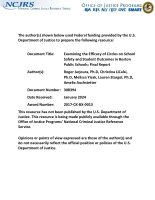Cluster analysis
Large Scale Microbiome Profiling in the Cloud
Evaluation of California's Armed and Prohibited Persons System Study Protocol for a Cluster-Randomized Trial
Estimating Labor Trafficking Among Farmworkers: An Inverse Sampling Strategy Based on Reliable Housing Predictions
Replicating Group-Based Trajectory Models of Crime at Micro-Places in Albany, NY
Stable Hydrogen and Oxygen Isotopes of Tap Water Reveal Structure of the San Francisco Bay Area's Water System and Adjustments During a Major Drought
Effect of Growth in Foreign Born Population Share on County Homicide Rates: A Spatial Panel Approach
Temporal Sequences Quantify the Contributions of Individual Fixations in Complex Perceptual Matching Tasks
Examining the Efficacy of Circles on School Safety and Student Outcomes in Boston Public Schools: Final Report
Forensic analysis of Salvia divinorum using multivariate statistical procedures. Part I: discrimination from related Salvia species
Activity Analysis in Crowded Environments Using Social Cues for Group Discovery and Human Interaction Modeling
Examining the Impacts of Body-Worn Cameras on Correctional Culture, Climate, and the Well-Being of Staff and Incarcerated Persons
Validating a novel tool for coding body worn camera footage of police-community member interactions
Linking emergency care and police department data to strengthen timely information on violence-related paediatric injuries
A panel of 74 AISNPs: Improved Ancestry Inference within Eastern Asia
Identifying PCP and four PCP analogs using the gold chloride microcrystalline test followed by raman microspectroscopy and chemometrics
A Data-Informed Response to Emerging Drugs
The emerging drug crisis in the U.S. touches both criminal justice and public health, and experts from both fields came together at NIJ’s 2023 National Research Conference to discuss strategies and tools to fight this problem. Dr. Frances Scott, NIJ scientist and program manager, continues the conference discussion with two fellow panelists: Ciena Bayard, the Method Development and Validation Program Manager for D.C. Office of the Chief Medical Examiner, and Haley Greene, the Deputy Epidemiologist for the Central Region for the Virginia Department of Health. Read the transcript.




